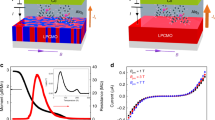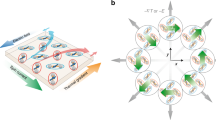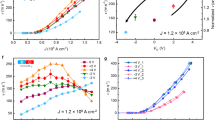Abstract
Organic semiconductors that are π-conjugated are emerging as an important platform for ‘spintronics’, which purports to harness the spin degree of freedom of a charge carrier to store, process and/or communicate information1. Here, we report the study of an organic nanowire spin valve device, 50 nm in diameter, consisting of a trilayer of ferromagnetic cobalt, an organic, Alq3, and ferromagnetic nickel. The measured spin relaxation time in the organic is found to be exceptionally long—between a few milliseconds and a second—and it is relatively temperature independent up to 100 K. Our experimental observations strongly suggest that the primary spin relaxation mechanism in the organic is the Elliott–Yafet mode, in which the spin relaxes whenever a carrier scatters and its velocity changes.
This is a preview of subscription content, access via your institution
Access options
Subscribe to this journal
Receive 12 print issues and online access
$259.00 per year
only $21.58 per issue
Buy this article
- Purchase on Springer Link
- Instant access to full article PDF
Prices may be subject to local taxes which are calculated during checkout




Similar content being viewed by others
References
Xiong, Z. H., Wu D., Vardeny Z. V. & Shi, J . Giant magnetoresistance in organic spin valves. Nature 427, 821–824 (2004).
Dediu, V., Murgia, M., Matacotta, F. C., Taliani C. & Barbanera, S. Room temperature spin polarized injection in organic semiconductor. Solid State Commun. 122, 181–184 (2002).
Forrest, S., Burrows, P. & Thompson, M. The dawn of organic electronics. IEEE Spectr. 37, 29–34 (Aug 2000).
Petta, J. R., Slater, S. K. & Ralph, D. C. Spin dependent transport in molecular tunnel junctions. Phys. Rev. Lett. 93, 136601 (2004).
Ruden, R. P. & Smith, D. L. Theory of spin injection into conjugated organic semiconductors. J. Appl. Phys. 95, 4898–4904 (2004).
Yu, Z. G., Berding, M. A. & Krishnamurthy, S. Spin drift, spin precession and magnetoresistance of non-collinear magnet–polymer–magnet structures. Phys. Rev. B 71, 060408(R) (2005).
Rocha, A. R., Garcia-Suarez, V. M., Bailey, S. W., Lambert, C. J., Ferrer, J. & Sanvito, S. Towards molecular spintronics. Nature Mater. 4, 335–339 (2005).
Pati, R., Senapati L., Ajayan, P. M. & Nayak, S. K. First principles calculations of spin polarized electron transport in a molecular wire: Molecular spin valve. Phys. Rev. B 68, 100407(R) (2003).
Zheng, M. et al. Magnetic properties of Ni nanowires in self assembled arrays. Phys. Rev. B 62, 12282–12286 (2000).
Francis, T. L., Mermer, O., Veeraraghavan, G. & Wohlgenannt, M. Large magnetoresistance at room temperature in semiconducting polymer sandwich devices. New J. Phys. 6, 185 (2004).
Mermer, Ö., Veeraraghavan, G., Francis, T. L. & Wohlgenannt, M. Large magnetoresistance at room temperature in small molecular weight organic semiconductor sandwich devices. Solid State Commun. 134, 631–636 (2005).
Pramanik, S., Bandyopadhyay, S., Garre, K. & Cahay, M. Normal and inverse spin valve effect in organic semiconductor nanowires and the background magnetoresistance. Phys. Rev. B 74, 235329 (2006).
Zeng, H. et al. Magnetic properties of self assembled Co nanowires of varying length and diameter. J. Appl. Phys. 87, 4718–4720 (2000).
McGuire T. I. & Potter, R. I. Anisotropic magnetoresistance in ferromagnetic 3d alloys. IEEE Trans. Magn. 11, 1018–1038 (1975).
Ohgai, T. et al. Template synthesis and magnetoresistance property of Ni and Co single nanowires electrodeposited into nanopores with a wide range of aspect ratios. J. Phys. D 36, 3109–3114 (2003).
Xie, S. J., Ahn, K. H., Smith, D. L., Bishop, A. R. & Saxena, A., Ground state properties of ferromagnetic metal/conjugated polymer interfaces. Phys. Rev. B 67, 125202 (2003).
Saikin, S. A drift-diffusion model for spin-polarized transport in a two-dimensional non-degenerate electron gas controlled by spin orbit interaction. J. Phys. Condens. Matter 16, 5071–5081 (2004).
Julliere, M. Tunneling between ferromagnetic films. Phys. Lett. A 54, 225–226 (1975).
Tsymbal, E. Y., Mryasov, O. N. & LeClair, P. R. Spin dependent tunneling in magnetic tunnel junctions. J. Phys. Condens. Matter 15, R109–R142 (2003).
Zahid, F., Ghosh, A. W., Paulsson, M., Polizzi, E. & Datta, S. Charging induced asymmetry in molecular conductors. Phys. Rev. B 70, 245317 (2004).
D'yakonov, M. I. & Perel', V. I. Orientation of electrons associated with the interband absorption of light in semiconductors. Sov. Phys. JETP 33, 1053–1059 (1971).
Elliott, R. J. Theory of the effect of spin orbit coupling on magnetic resonance in some semiconductors. Phys. Rev. 96, 266–279 (1954).
Abragam, A. The Principles of Nuclear Magnetism (Clarendon Press, Oxford, 1961).
Bir, G. L., Aronov, A. G. & Pikus, G. E. Spin relaxation of electrons due to scattering by holes. Sov. Phys. JETP 42, 705–712 (1976).
Sheng, Y. et al. Hyperfine interaction and magnetoresistance in organic semiconductors. Phys. Rev. B 74, 045213 (2006).
Sanvito, S. & Rocha, A. R. Molecular-spintronics: the art of driving spin through molecules. Preprint at http://arxiv.org/cond-mat/0605239 (2006).
Pokalyakin, V. et al. Proposed model for bistability in nanowire nonvolatile memory. J. Appl. Phys. 97, 124306 (2005).
Salis, G., Alvarado, S. F., Tschudy, M., Brunschwiler T. & Allenspach, R. Hysteretic electroluminescence in organic light-emitting diodes for spin injection. Phys. Rev. B. 70, 085203 (2004).
Chen, B. J. et al. Electron drift mobility and electroluminescent efficiency of tris(8-hydroxyquinolinolato) aluminum. Appl. Phys. Lett. 75, 4010–4012 (1999).
Acknowledgements
This work is supported by the US Air Force Office of Scientific Research under grant FA9550-04-1-0261, by the National Science Foundation under grant ECS-0608854 and by the US Department of Energy under grant DE-AC02-98CH10886 (subcontract from Brookhaven National Laboratory).
Author information
Authors and Affiliations
Contributions
S.B., S.Pr. and M.C. conceived and designed the experiments, S.Pr., C.G.S. and S.Pa conducted the experiments, S.Pr and K.G. fabricated the structures and S.B. wrote the paper.
Corresponding author
Ethics declarations
Competing interests
The authors declare no competing financial interests.
Supplementary information
Supplementary Information
Supplementary figures S1 and S2 (PDF 435 kb)
Rights and permissions
About this article
Cite this article
Pramanik, S., Stefanita, CG., Patibandla, S. et al. Observation of extremely long spin relaxation times in an organic nanowire spin valve. Nature Nanotech 2, 216–219 (2007). https://doi.org/10.1038/nnano.2007.64
Received:
Accepted:
Published:
Issue Date:
DOI: https://doi.org/10.1038/nnano.2007.64



